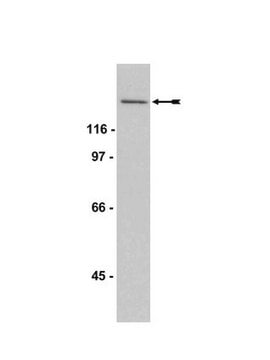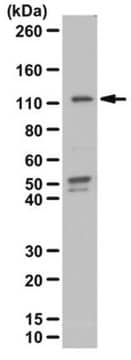ABN1675M
Anti-Nurr-1
from rabbit
Synonym(s):
Nuclear receptor subfamily 4 group A member 2, Immediate-early response protein NOT, Orphan nuclear receptor NURR1, Transcriptionally-inducible nuclear receptor, NR4A2
About This Item
Recommended Products
biological source
rabbit
Quality Level
antibody form
unpurified
antibody product type
primary antibodies
clone
polyclonal
species reactivity
mouse, human
species reactivity (predicted by homology)
rat (based on 100% sequence homology)
packaging
antibody small pack of 25 μL
technique(s)
ELISA: suitable
immunohistochemistry: suitable (paraffin)
western blot: suitable
isotype
IgG
NCBI accession no.
UniProt accession no.
target post-translational modification
unmodified
Gene Information
human ... NR4A2(4929)
General description
Specificity
Immunogen
Application
ELISA Analysis: A representative lot detected recombinant Nurr-1 LBDs (Courtesy of Dr. Pierre Leblanc at McLean Hospital, Belmont, MA).
Immunohistochemistry Analysis: A representative lot detected Nurr-1 in Midbrain dopamine neurons (Leblanc, P., et. al. (2015). J Vis Exp. (102):e52963).
Western Blotting Analysis: A 1:2,000 dilution from a representative lot detected Nurr-1 in HEK293T and CHO cells overexpressed with Myc-Tagged mouse full length Nurr1/Nor1/Nurr77 (Courtesy of Dr. Pierre Leblanc at McLean Hospital, Belmont, MA).
Immunohistochemistry Analysis: A 1:250-1:2,500 dilution from a representative lot detected Nurr-1 in mouse brain tissue sections.(Courtesy of Dr. Pierre Leblanc at McLean Hospital, Belmont, MA).
ELISA Analysis: A representative lot detected Nurr-1 ligand binding domain (Leblanc, P., et. al. (2015). J Vis Exp. (102):e52963).
Western Blotting Analysis: A representative lot detected Nurr-1 in CHO cells transfected with full-length myc-tagged Nurr-1 (Leblanc, P., et. al. (2015). J Vis Exp. (102):e52963).
Neuroscience
Quality
Immunohistochemistry (Paraffin) Analysis: A 1:50 dilution of this antibody detected Nurr-1 in mouse cerebral cortex tissue sections.
Target description
Physical form
Storage and Stability
Other Notes
Disclaimer
Not finding the right product?
Try our Product Selector Tool.
Storage Class Code
12 - Non Combustible Liquids
WGK
WGK 2
Certificates of Analysis (COA)
Search for Certificates of Analysis (COA) by entering the products Lot/Batch Number. Lot and Batch Numbers can be found on a product’s label following the words ‘Lot’ or ‘Batch’.
Already Own This Product?
Find documentation for the products that you have recently purchased in the Document Library.
Our team of scientists has experience in all areas of research including Life Science, Material Science, Chemical Synthesis, Chromatography, Analytical and many others.
Contact Technical Service








